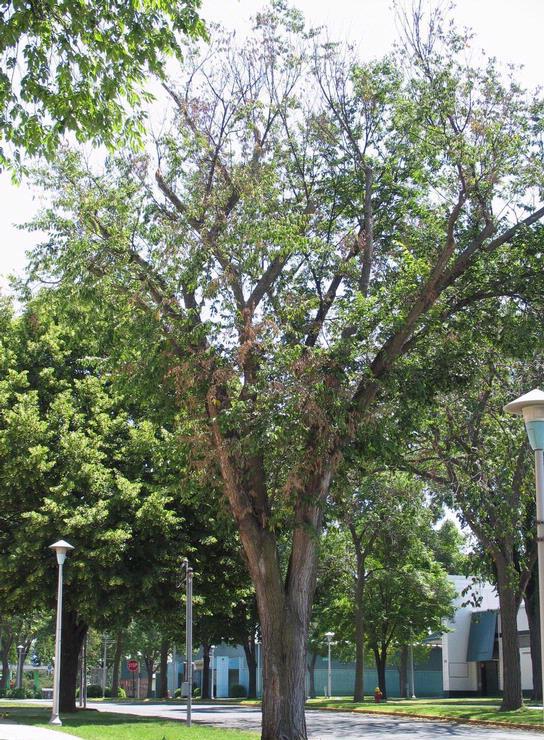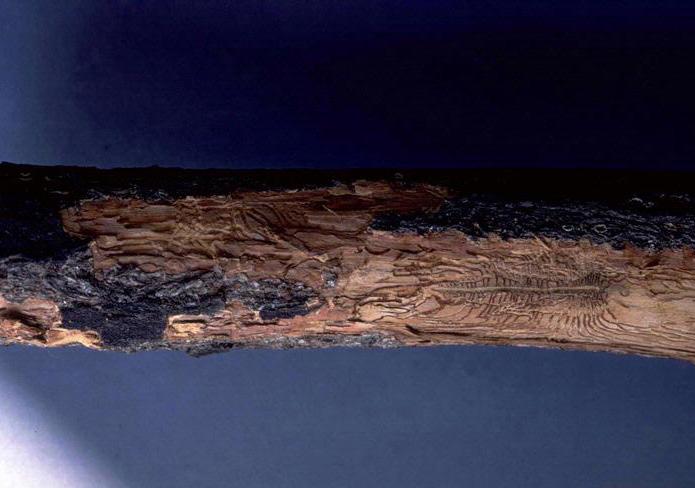
6 minute read
Dutch Elm Disease
Present in Utah
Background
Advertisement
Dutch elm disease (DED) is caused by two closely related fungi, Ophiostoma novo-ulmi and O. ulmi. These pathogens are primarily spread to hosts by elm bark beetles, but can also spread from infected to healthy trees through root-to-root contact. DED was first discovered in the Netherlands in 1921 and in the U.S. in Ohio in the 1930s. It is thought to have arrived to the U.S. on shipments of elm logs from France. DED is now found throughout much of North America, and was first recorded in Utah in 1982.
Plant Hosts & Susceptibility
All elm species (Ulmus) native to North America are susceptible to DED. American elm (U. americana) is highly susceptible; however, cultivars have been bred that have a greater tolerance to the disease (see table on page 12). European elms, such as camperdown elm (U. glabra ‘Camperdownii’), are moderately susceptible, and Asiatic elms, including Siberian elm (U. pumila) and Chinese or lacebark elm (U. parvifolia), are resistant. In Utah’s planted landscapes, Siberian elm is the most common elm species, along with sparse plantings of American elm and camperdown elm.
Description & Life Cycle
Three species of elm bark beetles can spread the fungi that cause DED, including the native elm bark beetle (Hylurgopinus rufipes), European elm bark beetle (Scolytus multistriatus), and banded elm bark beetle (S. schevyrewi). Only the European and banded elm bark beetles are associated with the disease in Utah.
The adults of both species are tiny and brown. They overwinter as larvae inside the host tree and emerge as adults in spring, seeking out healthy elms to feed in crotches of young twigs (“twig-feeding” stage). The adults then mate and lay eggs under the bark of diseased, stressed, or dying trees. After the eggs hatch and larvae mature, new adult beetles emerge from the trees to repeat the life cycle. There are two to three generations of elm bark beetles per year in Utah.
Beetles that emerge from previouslyinfected trees carry fungal spores on their bodies. Infection of susceptible elms happens during the twigfeeding stage. Spores are deposited on the feeding site, germinate, and form a mass of fungal mycelia that grows through the conductive tissues (xylem). The tree tries to stop the fungus by producing plug-like structures (tyloses), which block the flow of water. The pathogen can also spread via rootto-root contact with adjacent elms that are within 50 feet. These infections have a tendency to spread upward and more rapidly through the tree than beetle-vectored infections, which tend to spread downward.
Injury Symptoms
Symptoms of DED include wilting, yellowing (flagging) branches within the crown, and browning of foliage. They may appear anytime during the growing season and intensify during and after drought. Symptoms can also include dark streaking or staining in the xylem in newly-formed branches and stems. Beetle-vectored infections often develop symptoms in the upper crown first, whereas root-graft infections tend to show symptoms in the lower crown first. Some trees die within weeks of becoming infected, whereas others will struggle for years before eventually succumbing. Note that other biotic and abiotic diseases in Utah can cause flagging, including elm anthracnose, cankers, drought, elm yellows (also known as elm phloem necrosis), and nutrient deficiencies such as iron chlorosis.
Monitoring
Monitor trees regularly for signs of DED and beetle infestations. Review the chapter on elm bark beetles for more information about visual inspections and trapping.
Management
Don’t move firewood. Avoid transporting harmful tree pests by buying local firewood or gathering firewood on site, if permitted. Plant resistant varieties. See table on page 12 for American elm cultivars and other elm species that have shown greater tolerance to DED. Remove and destroy infected trees. Diseased branches can be pruned out if the infestation is caught early; otherwise, remove trees at ground level if more than 5% of the tree canopy is affected. Remove at least 10 feet below the last area of streaking and immediately destroy the branches and disinfect the pruning tools using a 10% bleach solution. Closely examine the entire branch circumference to be certain the fungus has been removed. Pruning should be done in late fall or winter when beetle activity is low. Properly dispose of tree trunks and branches by either burning, burying, chipping, or debarking cut wood.
Prevent disease spread from root
grafts. In areas where root grafts between elms are likely to occur, dig a trench 36 to 40 inches deep. Re-fill the trench with soil and immediately remove the diseased elm(s). Note that if more than 25% of a tree crown is damaged by DED, root severing may not save adjacent trees.
Use preventive fungicides. Protect high-value or specimen trees that have less than 5% damage with a yearly fungicide injection. Injections are not recommended for trees with rootgraft infections. Only experienced and licensed applicators should perform tree injections to prevent tree damage and ensure efficacy. Apply insecticides when necessary. Insecticides can kill the beetles that transmit DED. For more information, review the chapter on elm bark beetles in this guide.
Symptoms of Dutch elm disease include wilting and
yellowing foliage. Petr Kapitola, Central Institute for Supervising and Testing in Agriculture, Bugwood.org Flagging of foliage in an elm tree affected by Dutch


elm disease. Joseph OBrien, USDA Forest Service, Bugwood.org

Close up view of wilting leaves. Minnesota Department of
Natural Resources - FIA, Minnesota Department of Natural Resources, Bugwood.org

Streaking of vascular tissue due to Dutch elm disease.
North Carolina Forest Service, Bugwood.org

Dark rings are symptomatic of Dutch elm disease.
Bruce Watt, University of Maine, Bugwood.org

Vascular discoloration caused by Dutch elm disease.
Penn State Department of Plant Pathology & Environmental Microbiology Archives, Penn State University, Bugwood.org

Portion of an elm tree suffering from Dutch elm disease, with bark beetle galleries underneath the
bark. William M. Brown Jr., Bugwood.org Portion of elm wood affected by Dutch elm disease showing galleries created by the vector, European

elm bark beetle. William M. Brown Jr., Bugwood.org

Coremia (spore-bearing bodies) of Dutch elm disease in an elm bark beetle gallery. Joseph OBrien, USDA Forest
Service, Bugwood.org

Trenching around newly removed elms to prevent root graft transmission of Dutch elm disease. Whitney
Cranshaw, Colorado State University, Bugwood.org
Species Cultivar Resistant Tolerant
Ulmus americana (American or white elm) Jefferson X Lewis and Clark X New Harmony X Princeton X Valley Forge X American Liberty X Independence X Delaware X U. davidiana (David or Japanese elm) X U. parvifolia (Chinese or lacebark elm) Allee X Athena X Dynasty X Everclear X
U. pumila (Siberian elm) X
U. pumila x Ulmus japonica U. carpinifolia x Ulmus parvifolia
Cathedral Frontier X U. japonica x U. pumila New Horizon X Sapporo Autumn Gold X Vanguard X Ulmus ‘Urban’ x U. wilsoniana ‘Prospector’ Patriot X U. glabra x U. carpinifolia Pioneer X U. wilsoniana Prospector X U. japonica x U. wilsoniana Accolade X Danada X U. glabra x U. carpinifolia x U. pumila Homestead X U. japonica x U. pumila x U. wilsoniana (cross between ‘Accolade’ and ‘Vanguard’) Triumph X X

